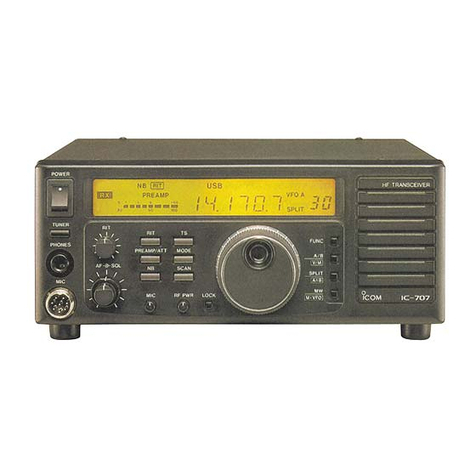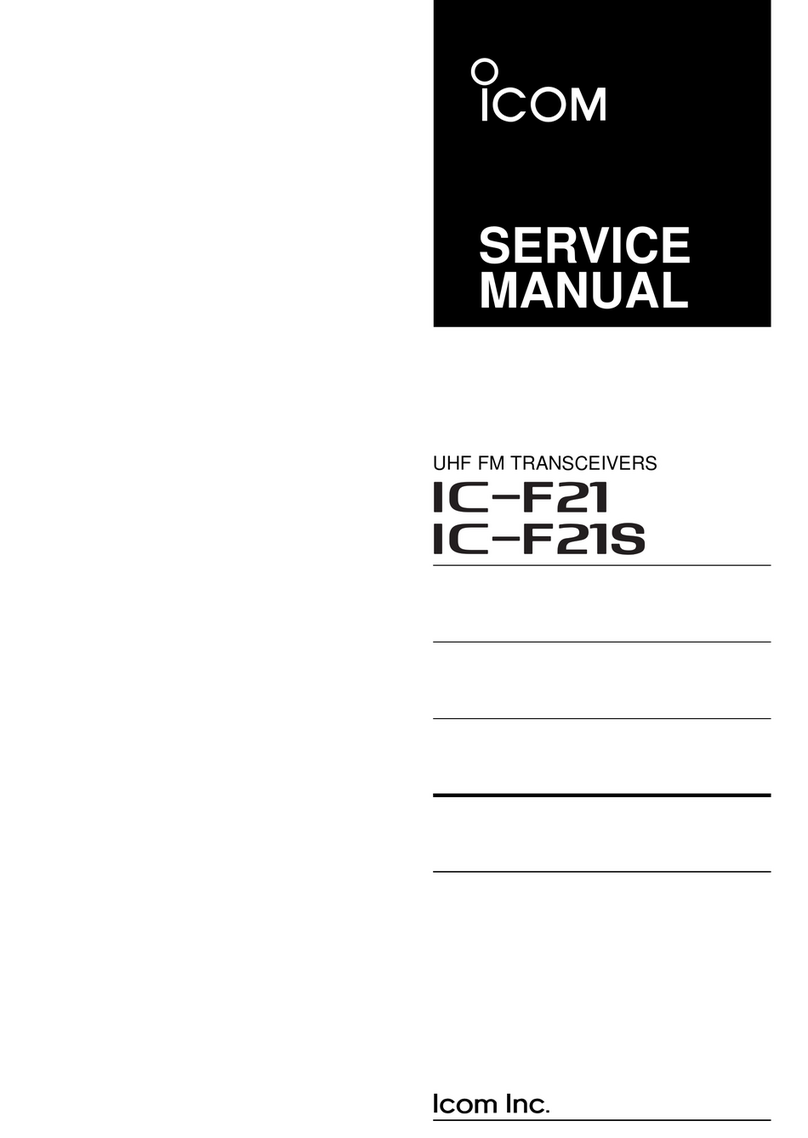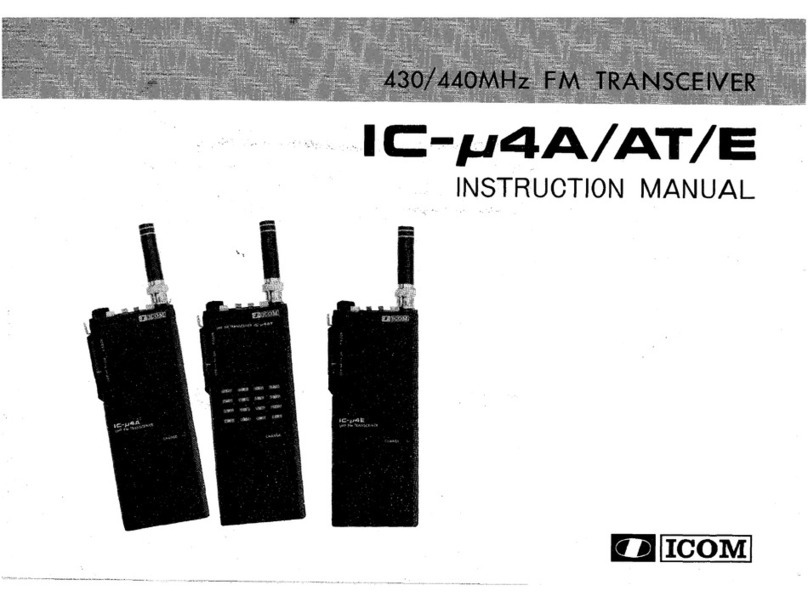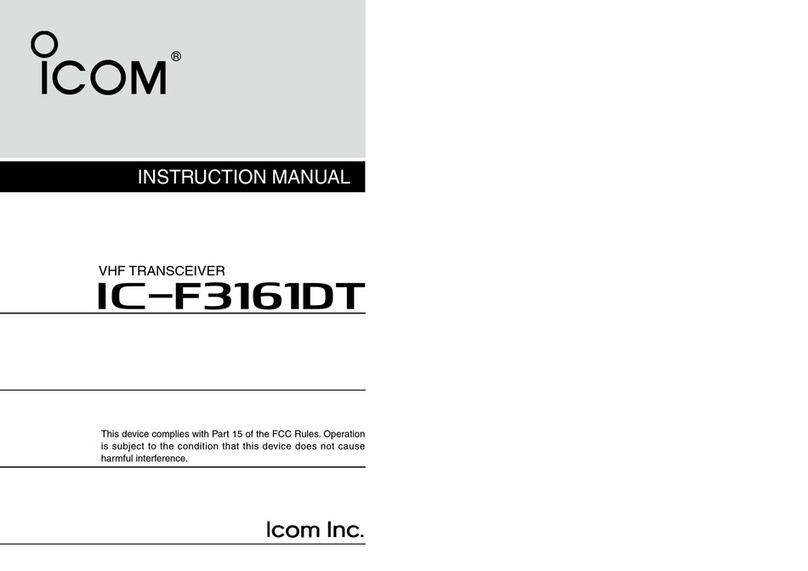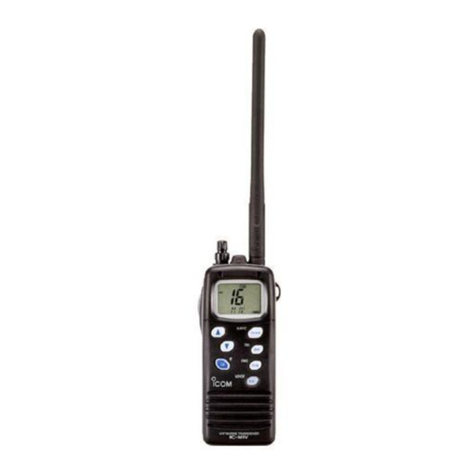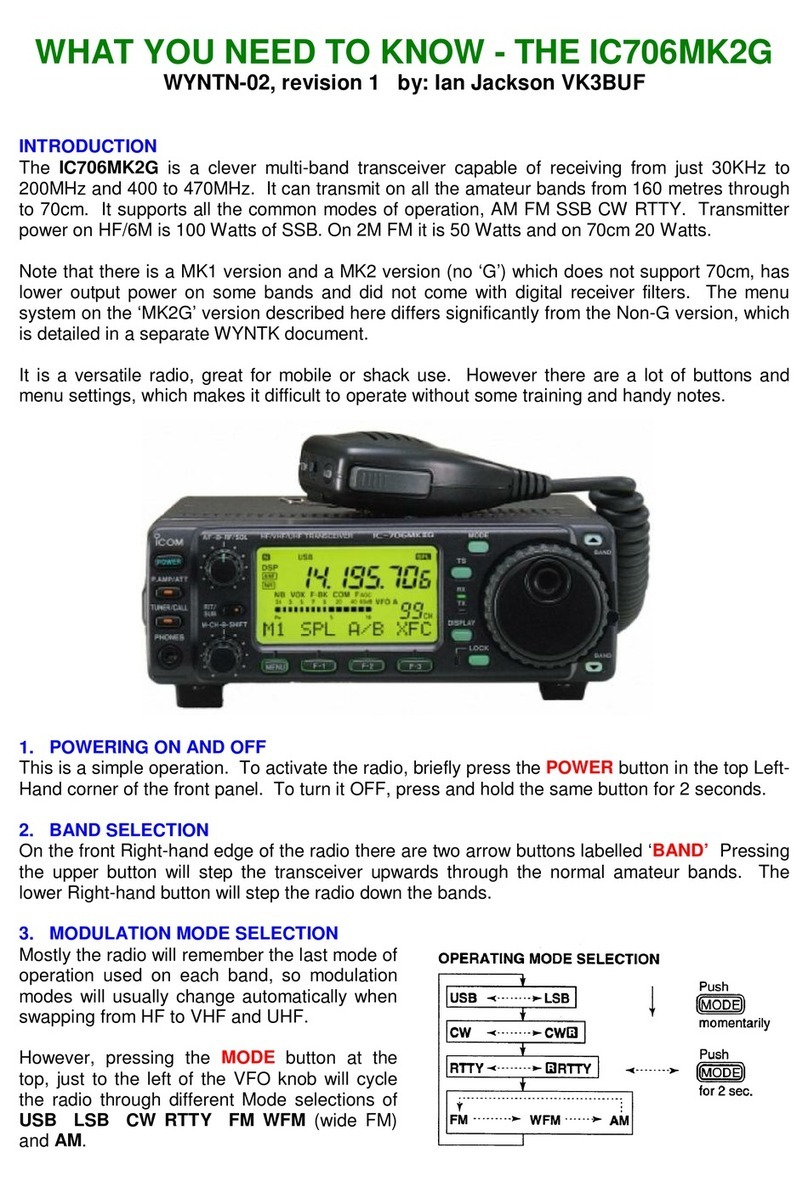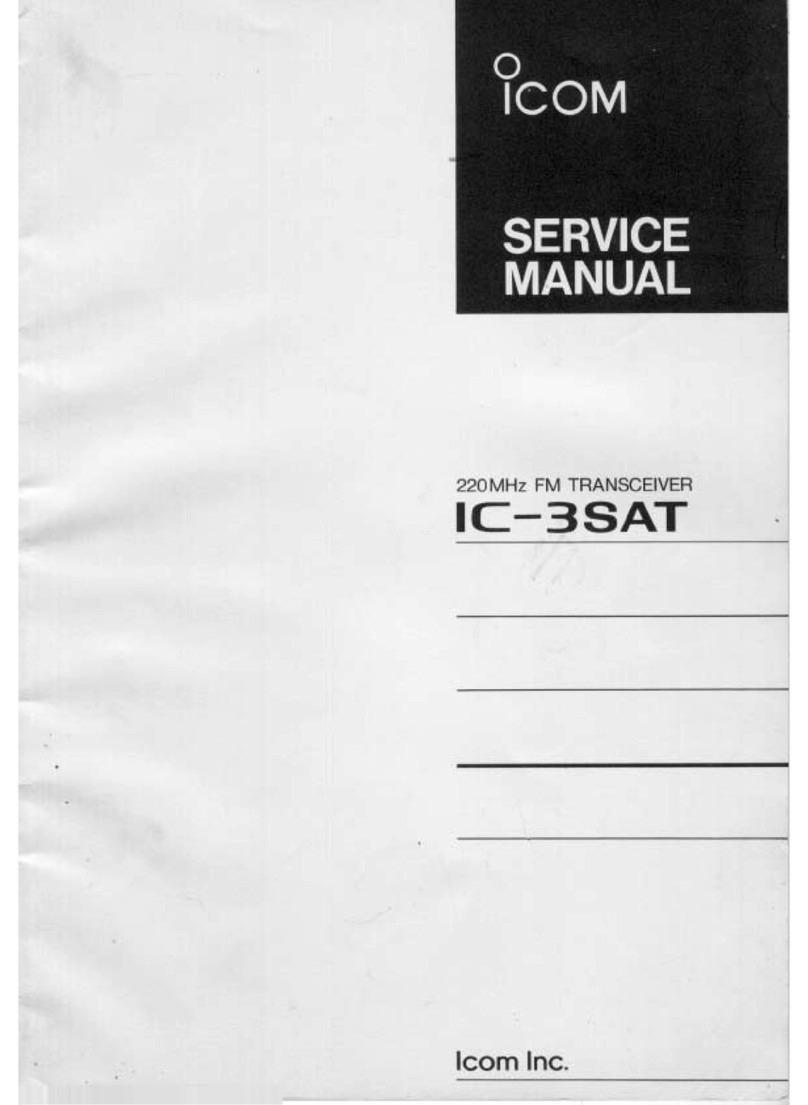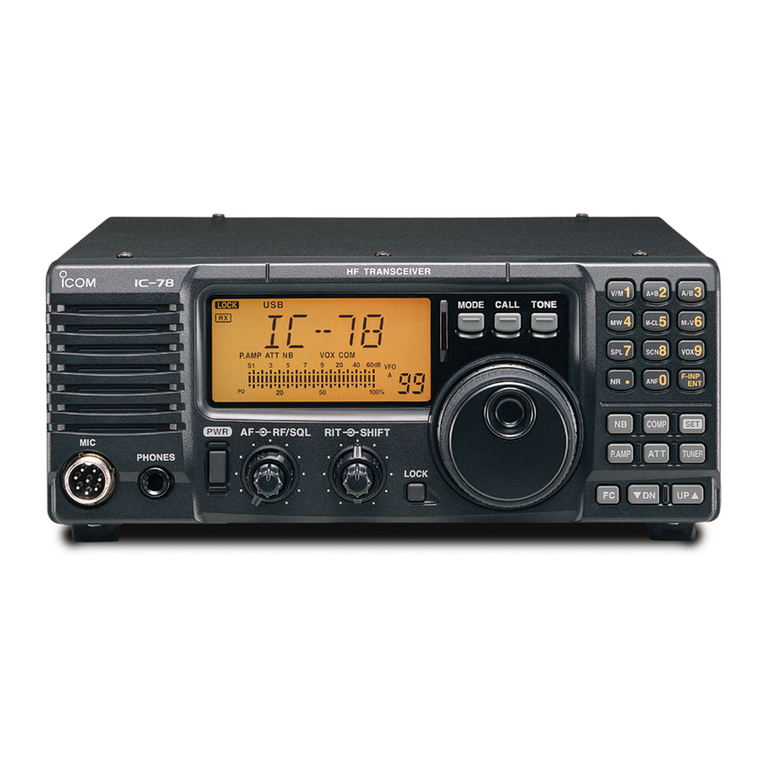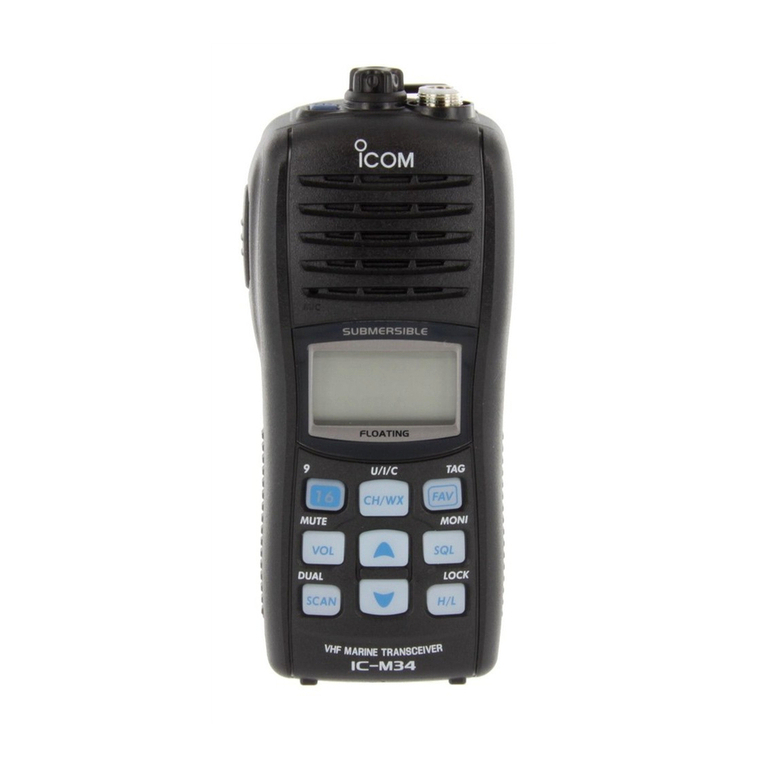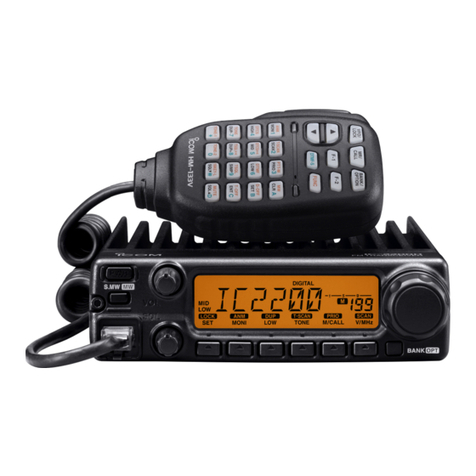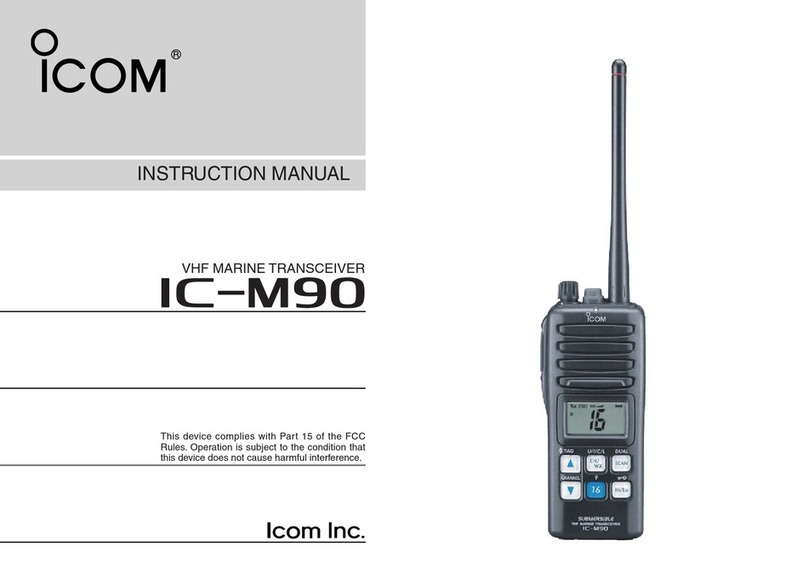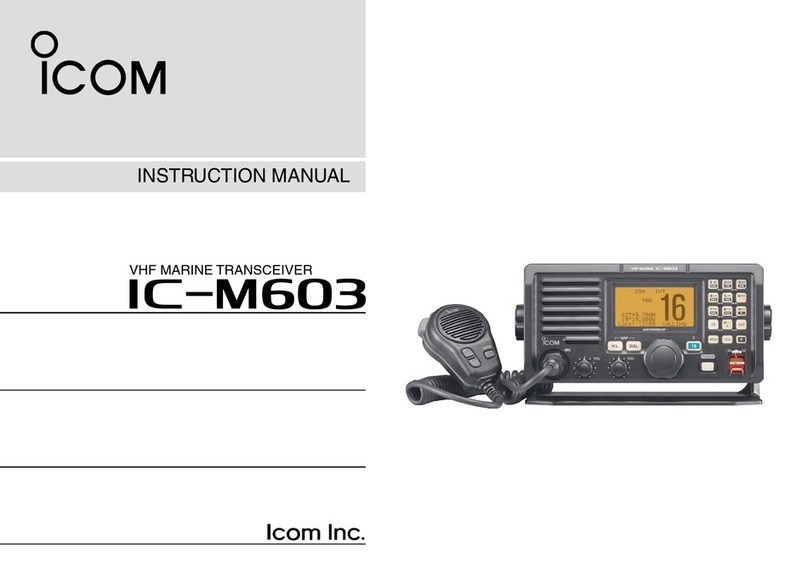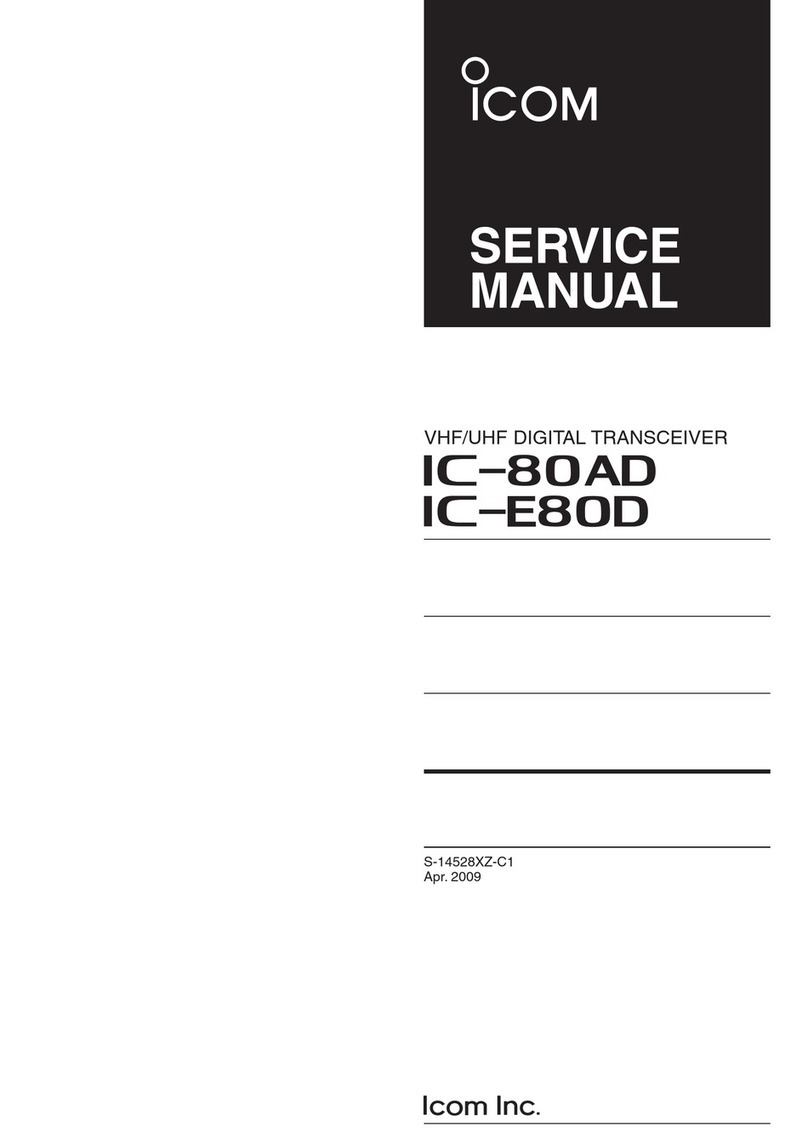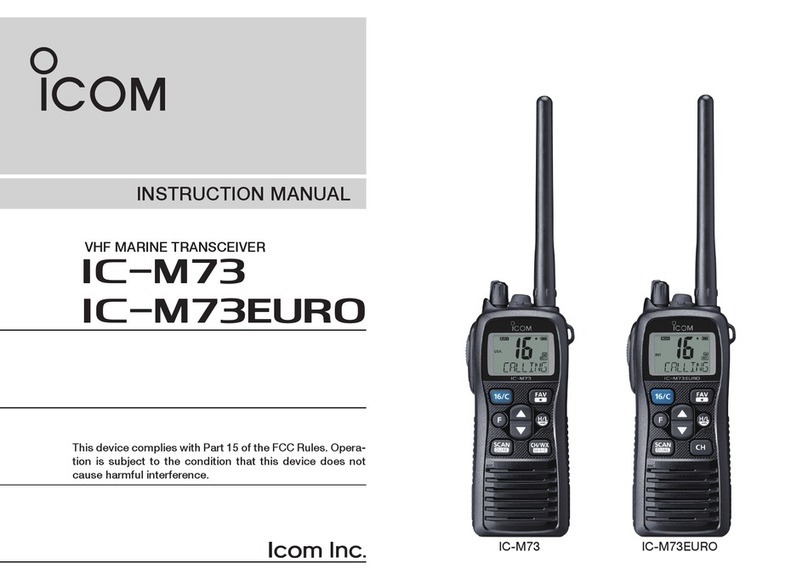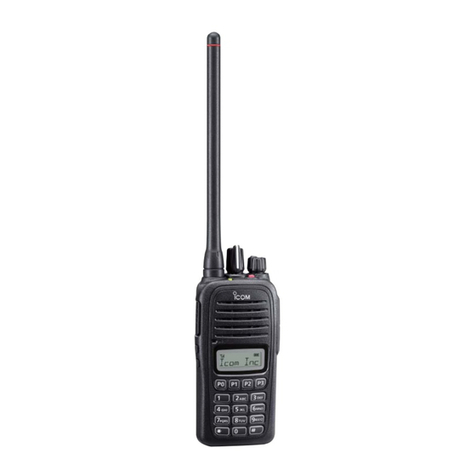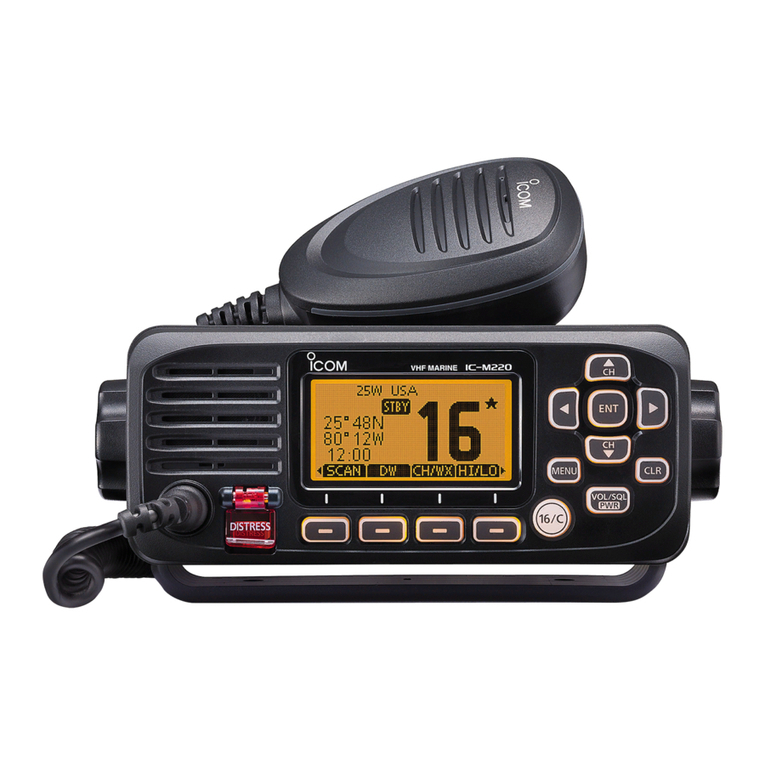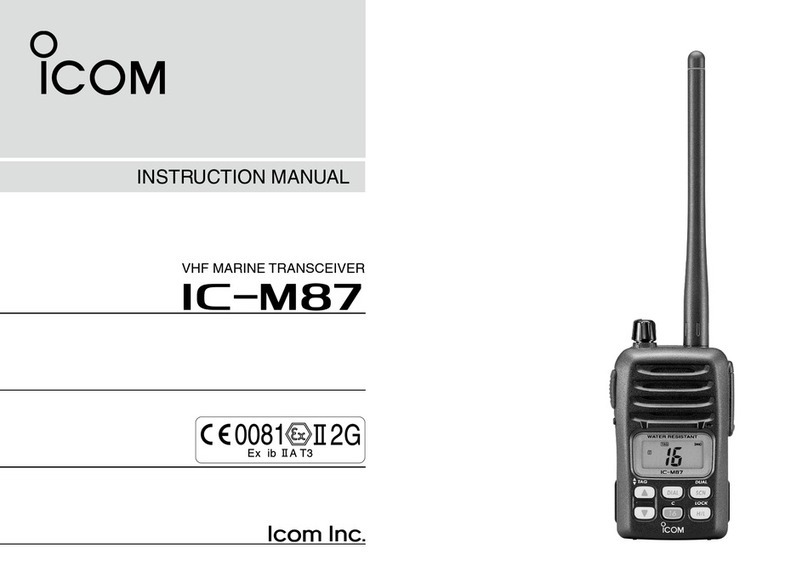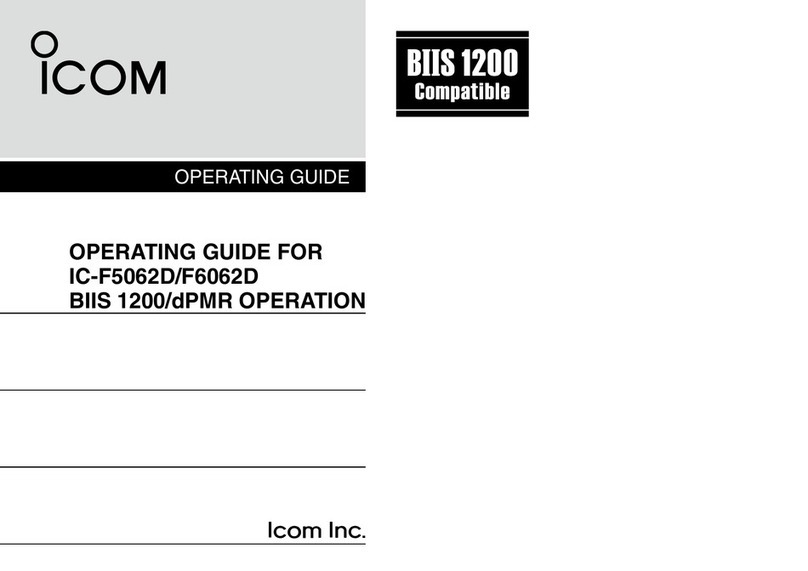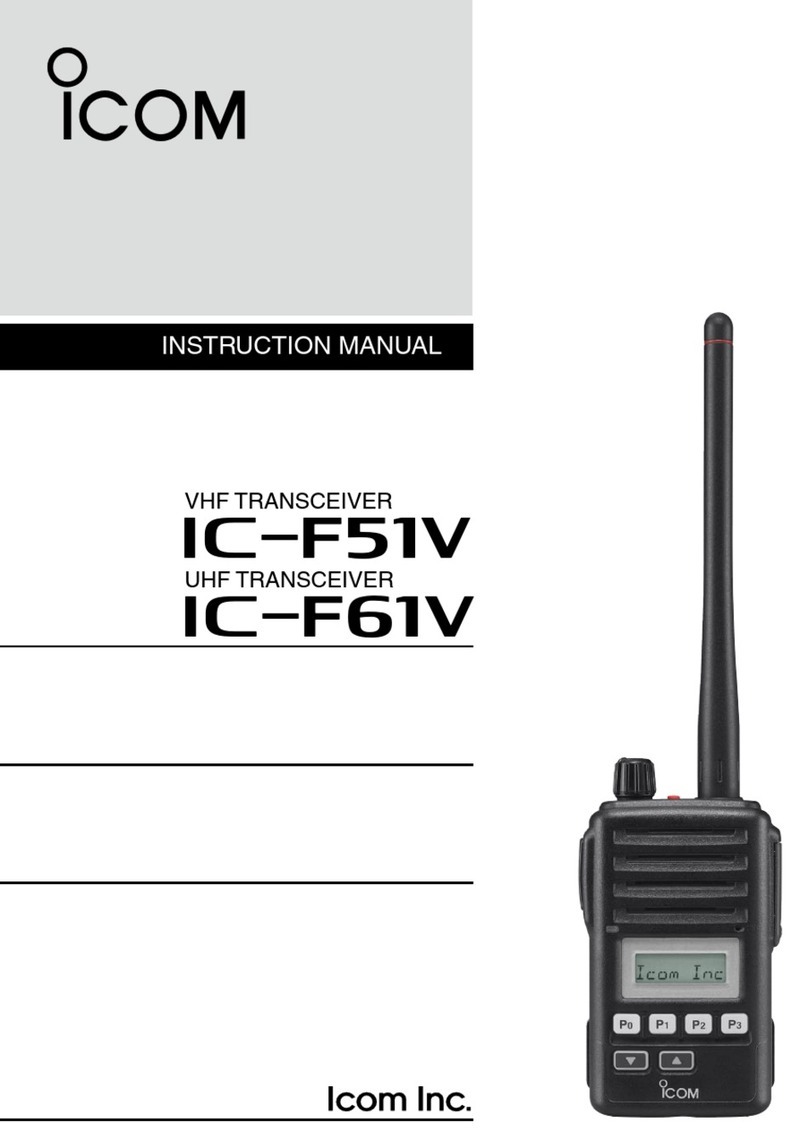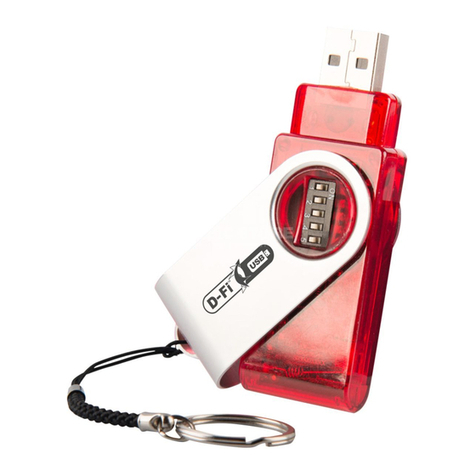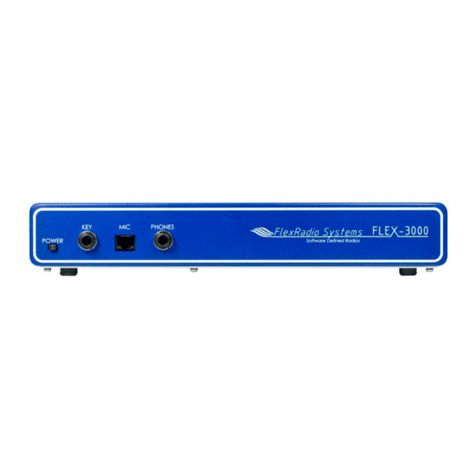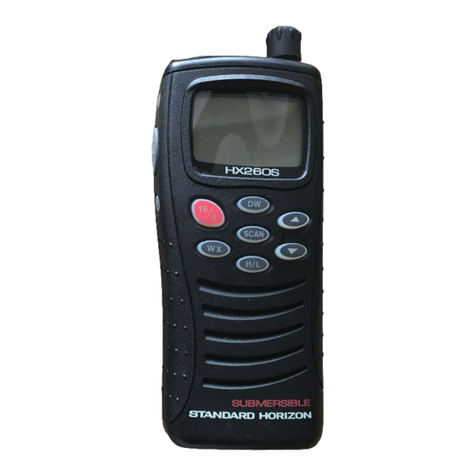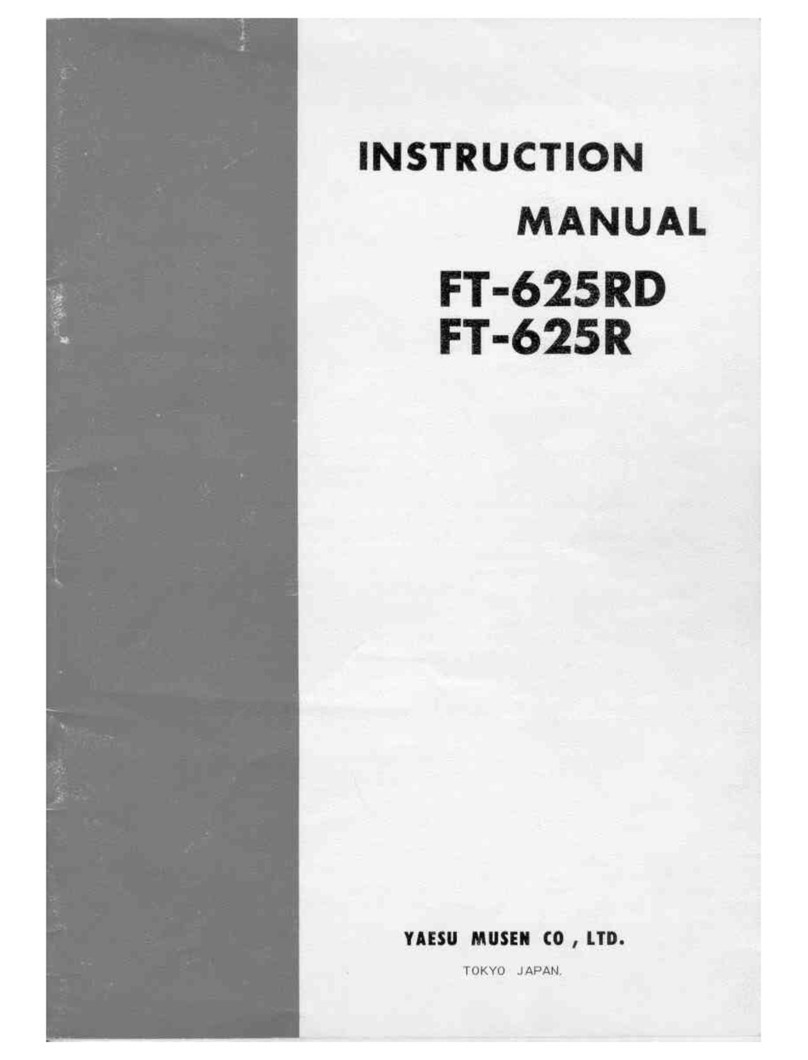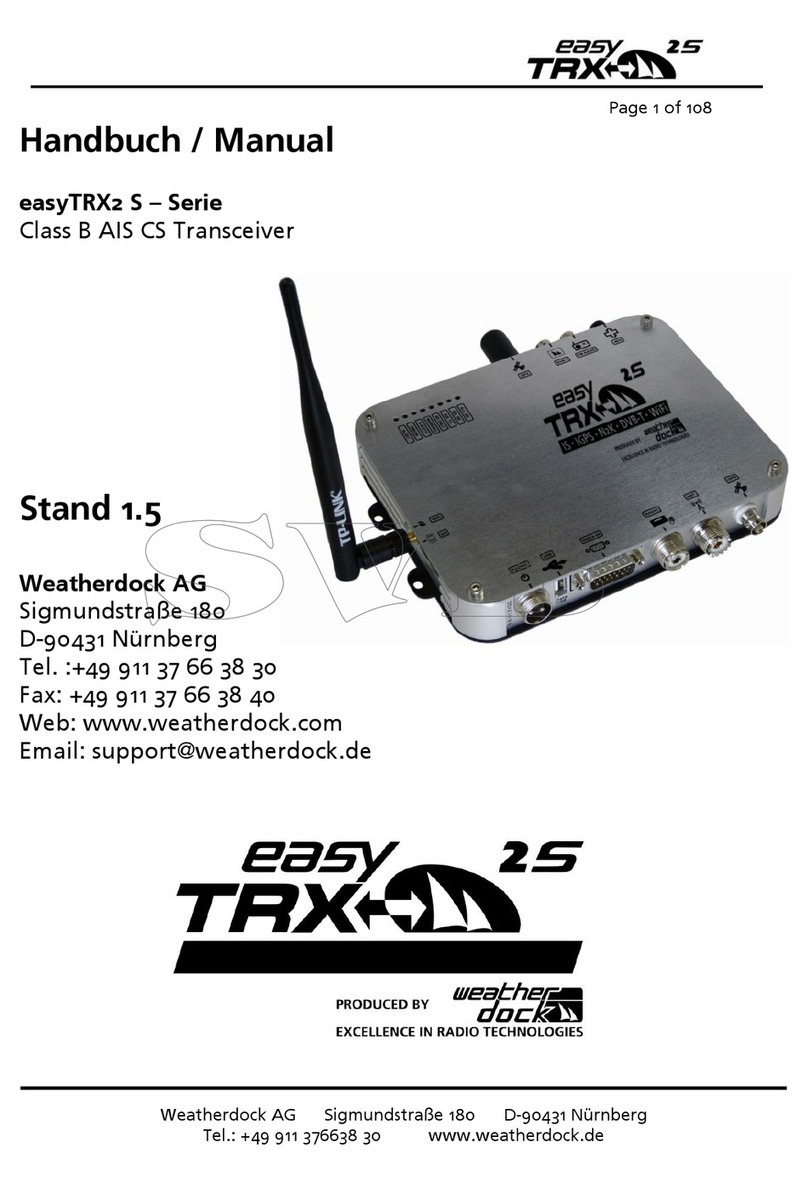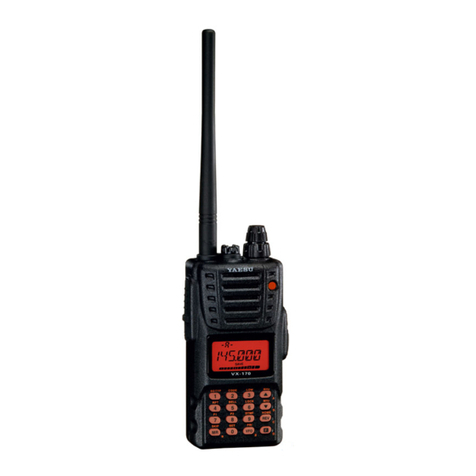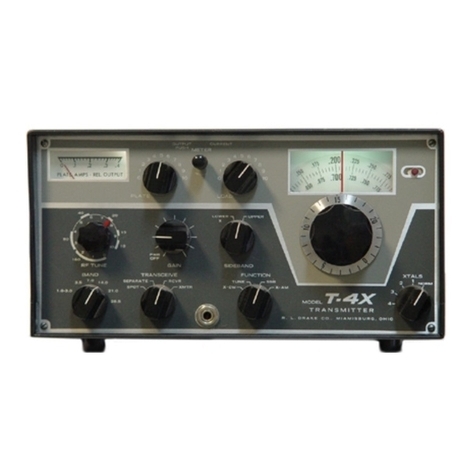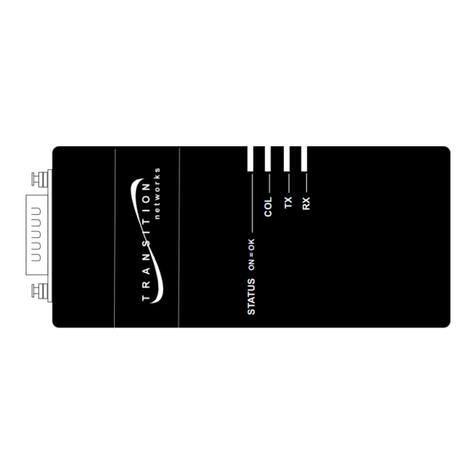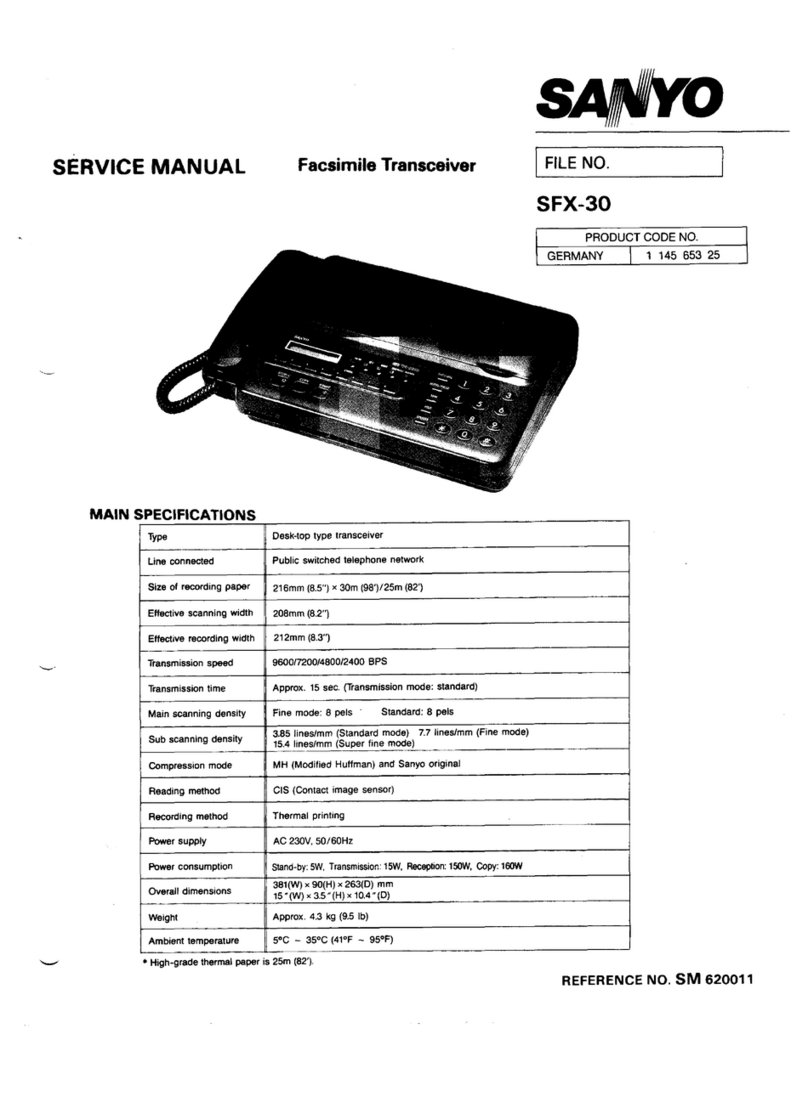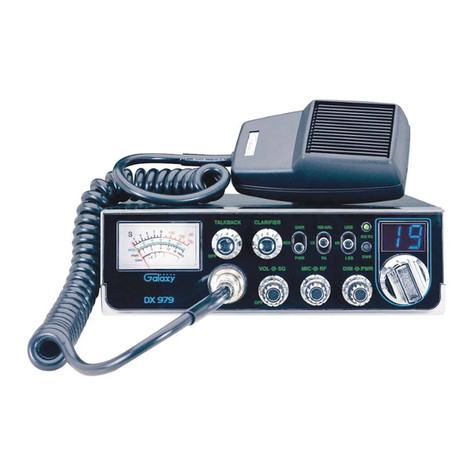Icom IC-M24 User manual

INSTRUCTION MANUAL
iM24
VHF MARINE TRANSCEIVER
This device complies with Part 15 of the FCC
Rules. Operation is subject to the condition that
this device does not cause harmful interference.

ii
FOREWORD
Thank you for purchasing this Icom radio. The IC-M24 VHF
MARINE TRANSCEIVER is designed and built with Icom’s state of
the art technology and craftsmanship. With proper care this
radio should provide you with years of trouble-free operation.
IMPORTANT
READ ALL INSTRUCTIONS carefully and com-
pletely before using the transceiver.
SAVE THIS INSTRUCTION MANUAL—This
instruction manual contains important operating instructions
for the IC-M24.
EXPLICIT DEFINITIONS
WORD DEFINITION
RDANGER! Personal death, serious injury or an explo-
sion may occur.
RWARNING! Personal injury, fire hazard or electric
shock may occur.
CAUTION Equipment damage may occur.
NOTE
If disregarded, only inconvenience. No risk
of personal injury, fire or electric shock.
FEATURES
☞Floats on water
The transceiver floats in fresh or salt
water even when the supplied acces-
sories are attached.
• When a third-party battery pack, strap, an-
tenna, etc. is used, it may sink.
☞Floats and flashes
An LED sends out intermittent light from
a transparent section on the bottom of
the radio, while floating in the water.
As the LED light stands out in the dark
(like a flashing fishing float), the radio
can be easily retrieved from the water.
This function works even when the
radio is turned OFF.
For Canada:
This device complies with RSS-310 of Industry Canada. Operation is subject
to the condition that this device does not cause harmful interference.
Cet appareil est conforme au CNR-310 d’Industrie Canada. Son exploitation
est autorisée sous réserve que l’appareil ne cause pas de brouillage
préjudiciable.

ii
IN CASE OF EMERGENCY RECOMMENDATION
If your vessel requires assistance, contact other vessels and
the Coast Guard by sending a distress call on Channel 16.
❍ USING CHANNEL 16
DISTRESS CALL PROCEDURE
1. “MAYDAY MAYDAY MAYDAY.”
2. “THIS IS ……………… ” (name of vessel)
3.Your call sign or other indication of the ves-
sel.
4. “LOCATED AT …………… ” (your position)
5. The nature of the distress and assistance
required.
6. Any other information which might facilitate
the rescue.
CLEAN THE TRANSCEIVER THOROUGHLY WITH FRESH
WATER after exposure to saltwater, and dry it before operat-
ing. Otherwise, the transceiver's keys, switches and control-
lers may become unusable due to salt crystallization.
NOTE: DO NOT submerge the transceiver in water if there
is any reason to suspect the waterproof protection may not
be effective. For example, in cases where the battery cover
or [DC] jack cap rubber seal is damaged, the transceiver/
battery cover/[DC] jack cap is cracked or broken, or the
transceiver has been dropped, or when the battery cover,
antenna or DC Jack cap are detached from the transceiver.
BP-266
BP-266
BP-266

iii
Your Icom radio generates RF electromagnetic energy during
transmit mode. This radio is designed for and classified as
“General Population Use” in an uncontrolled environment.
This radio has been evaluated for compliance at the distance
of 2.5 cm (1 inch) with the FCC RF exposure limits for “
Gen-
eral Population Use.
” In addition, your Icom radio complies
with the following Standards and Guidelines with regard to RF
energy and electromagnetic energy levels and evaluation of
such levels for exposure to humans:
• FCC OET Bulletin 65 Edition 01-01 Supplement C, Evaluating Compli-
ance with FCC Guidelines for Human Exposure to Radio Frequency
Electromagnetic Fields.
• American National Standards Institute (C95.1-1992), IEEE Standard
for Safety Levels with Respect to Human Exposure to Radio Frequency
Electromagnetic Fields, 3 kHz to 300 GHz.
• American National Standards Institute (C95.3-1992), IEEE Recom-
mended Practice for the Measurement of Potentially Hazardous Electro-
magnetic Fields– RF and Microwave.
• The following accessories are authorized for use with this product. Use of
accessories other than those specified may result in RF exposure levels
exceeding the FCC requirements for wireless RF exposure.; Belt Clip
(MB-124), Rechargeable Li-Ion Battery Pack (BP-266).
To ensure that your expose to RF electromagnetic en-
ergy is within the FCC allowable limits for general popu-
lation use, always adhere to the following guidelines:
• DO NOT operate the radio without a proper antenna attached, as this
may damaged the radio and may also cause you to exceed FCC RF ex-
posure limits. A proper antenna is the antenna supplied with this radio by
the manufacturer or antenna specifically authorized by the manufacturer
for use with this radio.
• DO NOT transmit for more than 50% of total radio use time (“50% duty
cycle”). Transmitting more than 50% of the time can cause FCC RF expo-
sure compliance requirements to be exceeded. The radio is transmitting
when the “transmit indicator” appears on the LCD. You can cause the
radio to transmit by pressing the “PTT” switch.
• ALWAYS keep the antenna at least 2.5 cm (1 inch) away from the body
when transmitting and only use the Icom belt clip which is listed on p. 28
when attaching the radio to your belt, etc., to ensure FCC RF exposure
compliance requirements are not exceeded. To provide the recipients of
your transmission the best sound quality, hold the antenna at least 5 cm
(2 inches) from your mouth, and slightly off to one side.
The information listed above provides the user with the information needed
to make him or her aware of RF exposure, and what to do to assure that this
radio operates with the FCC RF exposure limits of this radio.
Electromagnetic Interference/Compatibility
During transmissions, your Icom radio generates RF energy that can possibly
cause interference with other devices or systems. To avoid such interference,
turn off the radio in areas where signs are posted to do so. DO NOT operate
the transmitter in areas that are sensitive to electromagnetic radiation such as
hospitals, aircraft, and blasting sites.
SAFETY TRAINING INFORMATION

iv
Votre radio Icom produit une énergie électromagnétique
de radiofréquences (RF), en mode de transmission. Elle
est conçue pour une «utilisation grand public», dans un
environnement non contrôlé. Cet appareil a été évalué
et jugé conforme, à 2,5 cm, aux limites d'exposition aux
RF de la FCC, pour une «utilisation grand public». En
outre, votre radio Icom satisfait les normes et directives
qui suivent en matière de niveaux d'énergie et d'énergie
électromagnétique de RF et d'évaluation de tels niveaux en
ce qui concerne l'exposition humaine :
• Supplément C, édition 01-01, du Bulletin OET de la FCC, «Evaluating
Compliance with FCC Guidelines for Human Exposure to Radio Frequency
Electromagnetic Fields».
• Norme de l’American National Standards Institute (ANSI) : IEEE C95.1-
1992 sur les niveaux de sécurité compatibles avec l’exposition humaine aux
champs électromagnétiques de radiofréquences (3 kHz à 300 GHz).
• Norme de l’ANSI : IEEE C95.3-1992 sur la méthode d’évaluation
recommandée du champ magnétique potentiellement dangereux des
radiofréquences et des micro-ondes.
• Les accessoires qui suivent sont approuvés pour une utilisation avec ce
produit. L'utilisation d'accessoires autres que ceux précisés peut entraîner
des niveaux d'exposition aux RF supérieures aux limites établies par la FCC
en matière d'exposition aux RF sans fil; attache pour ceinture (MB-124),
bloc-piles rechargeable au lithium-ion (BP-266).
CAUTION
Afin de vous assurer que votre exposition à une
énergie électromagnétique de RF se situe dans les
limites permises par la FCC pour une utilisation grand
public, veuillez en tout temps respecter les directives
suivantes :
• NE PAS faire fonctionner la radio sans qu'une antenne appropriée y soit
fixée, car ceci risque d'endommager la radio et causer une exposition
supérieure aux limites établies par la FCC. L'antenne appropriée est celle
qui est fournie avec cette radio par le fabricant ou une antenne spécialement
autorisée par le fabricant pour être utilisée avec cette radio.
• NE PAS émettre pendant plus de 50% du temps total d'utilisation de
l'appareil («50% du facteur d'utilisation»). Émettre pendant plus de 50% du
temps total d'utilisation peut causer une exposition aux RF supérieure aux
limites établies par la FCC. La radio est en train d’émettre lorsque le témoin
du mode de transmission s'affiche sur l'écran ACL. La radio émettra si vous
appuyez sur le bouton du microphone.
• TOUJOURS tenir l'antenne éloignée d'au moins 2,5 cm de votre corps
au moment d'émettre et utiliser uniquement l'attache pour ceinture Icom
illustrée à la p. 28, lorsque vous attachez la radio à votre ceinture, ou à autre
chose, de façon à vous assurer de ne pas provoquer une exposition aux RF
supérieure aux limites fixées par la FCC. Pour offrir à vos interlocuteurs la
meilleure qualité de transmission possible, tenez l'antenne à au moins 5 cm
de votre bouche et légèrement de côté.
Les renseignements ci-dessus fournissent à l'utilisateur toute l'information
nécessaire sur l'exposition aux RF et sur ce qu'il faut faire pour assurer que
cette radio fonctionne en respectant les limites d'exposition aux RF établies
par la FCC.
Interférence électromagnétique et compatibilité
En mode de transmission, votre radio Icom produit de l'énergie de RF qui
peut provoquer des interférences avec d'autres appareils ou systèmes. Pour
éviter de telles interférences, mettez la radio hors tension dans les secteurs
où une signalisation l’exige. NE PAS faire fonctionner l'émetteur dans des
secteurs sensibles au rayonnement électromagnétique tels que les hôpitaux,
les aéronefs et les sites de dynamitage.
INFORMATION EN MATIÈRE DE SÉCURITÉ
AVERTISSEMENT
MISE EN GARDE

v
RWARNING! NEVER connect the transceiver to an
AC outlet. This may pose a fire hazard or result in an electric
shock.
RWARNING! NEVER hold the transceiver so that
the antenna is closer than 2.5 cm (1 inch) from exposed
parts of the body, especially the face or eyes, while transmit-
ting. The transceiver will perform best if the microphone is
5 to 10 cm (2 to 4 inches) away from the lips and the trans-
ceiver is vertical.
CAUTION: NEVER connect the transceiver to a
power source other than the BC-199 or BP-266. Such a con-
nection will ruin the transceiver.
DO NOT use or place the transceiver in direct sunlight
or in areas with temperatures below –20°C (–4°F) or above
+60°C (+140°F).
KEEP the transceiver out of the reach of children.
KEEP the transceiver at least 0.9 meters (3.0 ft) away
from your vessel’s magnetic navigation compass.
BE CAREFUL! The transceiver meets IPX7* require-
ments for waterproof protection. However, once the trans-
ceiver has been dropped, waterproof protection cannot be
guaranteed because of possible damage to the transceiver's
case or the waterproof seal.
* Only when the flexible antenna, battery cover and [DC] jack cap
are securely attached.
MAKE SURE the flexible antenna and battery cover are
securely attached to the transceiver, and that the antenna
and battery cover are dry before attachment. Exposing the
inside of the transceiver to water will result in serious dam-
age to the transceiver.
Icom, Icom Inc. and the Icom logo are registered trademarks of Icom Incor-
porated (Japan) in Japan, the United States, the United Kingdom, Germany,
France, Spain, Russia and/or other countries.
PRECAUTIONS

vi
FOREWORD ..................................................................................... i
IMPORTANT...................................................................................... i
EXPLICIT DEFINITIONS................................................................... i
FEATURES........................................................................................ i
IN CASE OF EMERGENCY............................................................. ii
RECOMMENDATION ....................................................................... ii
SAFETY TRAINING INFORMATION............................................... iii
INFORMATION EN MATIÈRE DE SÉCURITÉ................................ iv
PRECAUTIONS................................................................................ v
TABLE OF CONTENTS................................................................... vi
FCC INFORMATION ...................................................................... vii
1 OPERATING RULES ..................................................................1
2 SUPPLIED ACCESSORIES AND ATTACHMENTS...............2–3
■Supplied accessories...............................................................2
■Attachments.............................................................................2
3 PANEL DESCRIPTION ........................................................... 4–7
■Front, top and side panels .......................................................4
■Function display.......................................................................6
4 BASIC OPERATION ............................................................. 8–13
■Channel selection ....................................................................8
■Adjusting the volume level .....................................................10
■Adjusting the squelch level ....................................................10
■Receiving and transmitting ....................................................11
■Call channel programming.....................................................12
■Volume Loud function ............................................................12
■Volume Mute function ............................................................12
■Lock function..........................................................................13
■Monitor function .....................................................................13
■Automatic backlighting...........................................................13
■AquaQuake Water Draining function......................................13
5 SCAN OPERATION ............................................................14–15
■Scan types.............................................................................14
■Setting TAG channels ............................................................15
■Starting a scan.......................................................................15
6 DUALWATCH/TRI-WATCH .......................................................16
■Description.............................................................................16
■Operation...............................................................................16
7 SET MODE..........................................................................17–20
■Set mode programming .........................................................17
■Set mode items......................................................................18
8 BATTERY CHARGING .......................................................21–25
■Battery caution.......................................................................21
■Supplied battery charger .......................................................23
■Optional battery charger ........................................................23
9 TROUBLESHOOTING ..............................................................26
10 VHF MARINE CHANNEL LIST.................................................27
11 SPECIFICATIONS AND OPTIONS...........................................28
■Specifications.........................................................................28
■Options ..................................................................................28
TABLE OF CONTENTS

vii
FOR CLASS B UNINTENTIONAL RADIATORS
This equipment has been tested and found to comply with
the limits for a Class B digital device, pursuant to part 15 of
the FCC Rules. These limits are designed to provide reason-
able protection against harmful interference in a residential
installation. This equipment generates, uses and can radiate
radio frequency energy and, if not installed and used in ac-
cordance with the instructions, may cause harmful interfer-
ence to radio communications. However, there is no guaran-
tee that interference will not occur in a particular installation.
If this equipment does cause harmful interference to radio
or television reception, which can be determined by turning
the equipment off and on, the user is encouraged to try to
correct the interference by one or more of the following mea-
sures:
• Reorient or relocate the receiving antenna.
• Increase the separation between the equipment and re-
ceiver.
• Connect the equipment into an outlet on a circuit different
from that to which the receiver is connected.
• Consult the dealer or an experienced radio/TV technician
for help.
CAUTION: Changes or modifications to this device, not
expressly approved by Icom Inc., could void your authority to
operate this device under FCC regulations.
FCC INFORMATION

D Priorities
• Read all rules and regulations pertaining to call priorities,
and keep an up-to-date copy handy. Safety and distress
calls take priority over all others.
• You must monitor Channel 16 when you are not operating
on another channel.
• False or fraudulent distress calls are prohibited under law.
D Privacy
• Information overheard, but not intended for you, cannot
lawfully be used in any way.
• Indecent or profane language is prohibited.
D Radio licenses
(1) SHIP STATION LICENSE
You may require a current radio station license before using
the transceiver. It is unlawful to operate a ship station which
is not licensed, but required to be.
If required, contact your dealer or the appropriate govern-
ment agency for a Ship-Radiotelephone license application.
This government-issued license states the call sign which is
your craft’s identification for radio purposes.
(2) OPERATOR’S LICENSE
A Restricted Radiotelephone Operator Permit is the license
most often held by small vessel radio operators when a radio
is not required for safety purposes.
If required, the Restricted Radiotelephone Operator Permit
must be posted or kept with the operator. If required, only a
licensed radio operator may operate a transceiver.
However, non-licensed individuals may talk over a trans-
ceiver if a licensed operator starts, supervises, ends the call
and makes the necessary log entries.
A current copy of the applicable government rules and regu-
lations is only required to be on hand for vessels in which a
radio telephone is compulsory. However, even if you are not
required to have these on hand it is your responsibility to be
thoroughly acquainted with all pertinent rules and regula-
tions.
NOTE: Even though the IC-M24 is capable of operation
on VHF marine channels 3, 21, 23, 61, 64, 81, 82 and
83, according to FCC regulations these simplex channels
cannot be lawfully used by the general population in USA
waters.
1
1
OPERATING RULES
1
2
3
4
5
6
7
8
9
10
11
12
13
14
15
16

2
SUPPLIED ACCESSORIES AND ATTACHMENTS
2
■Supplied accessories
■Attachments
DFlexible antenna
Connect the supplied flexible an-
tenna to the antenna connector.
CAUTION:
• NEVER carry the transceiver by
holding just the antenna.
• Transmitting without an antenna
can damage the transceiver.
DHandstrap
Pass the handstrap through
the loop on the back side of
the transceiver as shown.
DBelt clip
Attach the belt clip to, or detach the belt clip from the transceiver.
Battery packHandstrap
Belt clip
Flexible antenna
Charger
BP-266
BP-266
BP-266
BP-266
BP-266
BP-266
BP-266
BP-266
BP-266
To attach the belt clip To detach the belt clip
Be careful!
Don’t break your
fingernail.
q
Belt clip
w
BP-266
BP-266
Lift the tab up (q), and slide
the belt clip in the direction
of the arrow (w).
BP-266

Make sure the rubber seal is properly seated in the
groove and there is dust or other material is on it.
BP-266
BP-266
Rubber seal
Groove
Battery cover Battery cover
Correct position Incorrect position
BP-266
DBattery pack
To remove the battery pack:
Slide the latch and then lift the battery cover to remove it.
Then remove the battery pack, as shown.
To insert the battery pack:
Place the battery pack into the transceiver so it fits flat, and
then securely attach
the battery cover, as shown.
NEVER remove the
battery cover
when the transceiver is
wet or soiled. This may result in water or dust getting into
the transceiver/battery pack, and may result in the trans-
ceiver being damaged.
CAUTION:
•
When attaching or removing the battery cover, make sure
the rubber seal is correctly set in the groove of the cover.
If the seal is not correctly in the groove, it may be dam-
aged when attaching the battery cover. If the seal is dam-
aged, waterproof protection is not guaranteed.
•
When attaching the battery cover, make sure dust or
other material does not adhere to the rubber seal. If dust
or other material is on the seal when attaching the battery
cover, waterproof protection may not be guaranteed.
3
2
SUPPLIED ACCESSORIES AND ATTACHMENTS
1
2
3
4
5
6
7
8
9
10
11
12
13
14
15
16
BP-266
BP-266
Latch
Battery cover
BP-266
BP-266
BP-266
Push the cover until
the latch comes back
to the locked position.
Battery cover
“Click”
BP-266
BP-266
BP-266
Battery pack
BP-266

4
PANEL DESCRIPTION
3
■
Front, top and side panels
qANTENNA CONNECTOR (p. 2)
Connect the supplied antenna here.
w
DC JACK [DC] (p. 23)
Connect the charger or optional cable here.
NOTE: Attach the [DC] jack cap when the charger or op-
tional cable is not connected. Otherwise, water will get into
the transceiver. When attaching the [DC] jack cap, make
sure dust or other material does not adhere to the rubber
seal. If dust or other material is on the seal when attaching
the cap, waterproof protection may not be guaranteed.
e PTT SWITCH [PTT]
Hold down to transmit; release to receive. (p. 11)
rCHANNEL 16 KEY [16 9]
➥Push to select Channel 16. (p. 8)
➥
Hold down for 1 second to select the Call channel. (p. 8)
➥
When the Call channel is selected, hold down for 3 seconds
to enter the Call channel programming mode.(p.12)
➥While in the Set mode, push to return to the normal op-
erating mode.(p.17)
Function
display
(pp. 6, 7)
Speaker
y
t
r
e
u
w
q
!1
o
i
!0
Microphone
BP-266
BP-266
BP-266
qTo remove the
[DC]
jack cap, rotate it
counter clockwise.
BP-266
BP-266
BP-266
wPull the cap up to detach it.
BP-266
BP-266
BP-266

t VOLUME/SQUELCH/MONITOR KEY [VOL/SQL MONI]
➥Push to enter the volume adjustment mode or the
squelch adjustment mode. (p. 10)
➥Hold down for 1 second to activate the Monitor func-
tion. (p. 13)
➥While holding down this key, hold down []to turn ON
the power and enter the Set mode. (p. 17)
➥While in the Set mode, push to select an item. (p. 17)
➥While holding down this key, push [Z] to turn ON the
Volume Mute function. Do the same steps again to turn
OFF the function. (p. 12)
➥While holding down this key, push [Y] to turn ON the
Volume Loud function. Do the same steps again to turn
OFF the function. (p. 12)
ySCAN/DUAL KEY [SCAN DUAL]
➥Push to start or stop a normal or priority scan. (p. 15)
➥
Hold down for 1 second to enter the Dual/Tri-watch
mode. (p. 16)
➥Push to exit the watch mode. (p. 16)
➥Hold down this key and
[Hi/Lo]
for 1 second, to activate
the Aq
uaQuake function. (p. 13)
uUP/DOWN KEYS [Y]or [Z]
➥Push to select an operating channel. (pp. 8, 9)
➥While in the Set mode, push to select the setting or
value of an item. (p. 17)
➥Push to check TAG channels or change scanning direc-
tion during a scan. (p. 15)
iFAVORITE/TAG KEY [FAV TAG]
➥Push to sequentially select the favorite (TAG) chan-
nels, while ignoring untagged channels, in a channel
group. (p. 8)
➥Hold down for 1 second to set or clear the TAG for the
displayed channel. (p. 15)
➥While holding down, turn ON the power to clear or set
all TAG channels in the selected channel group. (p. 15)
oCHANNEL/WEATHER CHANNEL KEY [CH/WX U/I/C]
➥Push to switch between a regular channel and a
weather channel. (p. 9)
➥Hold down for 1 second to select the USA, International
and Canada channel groups. (p. 9)
➥Push to return to the previous channel before selecting
Channel 16 or the Call channel. (p. 8)
!0 POWER KEY [ ]
Hold down to turn power ON or OFF.
!1 TRANSMIT POWER/LOCK KEY [Hi/Lo ]
➥
Push to
select the
high
or
low
output power
.
(p.11)
➥Hold down for 1 second to turn the Lock function ON or
OFF. (p. 13)
5
3
PANEL DESCRIPTION
1
2
3
4
5
6
7
8
9
10
11
12
13
14
15
16
Volume adjustment mode
Normal operating mode
Squelch adjustment mode
PUSH
PUSH
PUSH
BP-266
BP-266
BP-266

6
3PANEL DESCRIPTION
■Function display
q TRANSMIT ICON (p. 11)
Appears while transmitting.
w BUSY ICON
➥Appears while receiving a signal or when the squelch
opens. (p. 11)
➥Blinks while monitoring. (p. 13)
e TAG CHANNEL ICON (p. 15)
Appears when a TAG channel is selected.
r CALL CHANNEL ICON (p. 8)
Appears when the Call channel is selected.
t CHARGE ICON (p. 23)
Appears while charging.
y BATTERY ICONS
➥Displays the remaining battery capacity.
Indication
Full Middle Charging
required Exhausted
Battery status
blinks when the battery is over charged.
BP-266
BP-266
BP-266
➥Scrolls while charging. (p. 23)
u SCAN ICON (p. 15)
Blinks during a scan.
i LOCK ICON (p. 13)
Appears when the Lock function is turned ON.
o DUALWATCH/TRI-WATCH ICONS (p. 16)
“DW” appears during Dualwatch; “TW” appears during Tri-
watch.
!0 DUPLEX ICON
Appears when a duplex channel is selected.
!4
!3
i
u
o
!2
!1
!0
!7
!5
qerytw
!6
BP-266
BP-266
BP-266
BP-266
BP-266
BP-266

!1 SUB CHANNEL READOUT
➥Displays Channel 16 during a priority scan, Dualwatch
or Tri-watch. (p. 16)
➥Displays the Set mode item while in the Set mode. (p. 17)
➥Displays the volume level while in the volume adjust-
ment mode. (p. 10)
➥Displays the squelch level while in the squelch adjust-
ment mode. (p. 10)
!2 SQUELCH LEVEL ICON
➥Displays the squelch level.
➥“ SQL” blinks while adjusting the squelch level. (p. 10)
!3 VOLUME LEVEL ICON
➥Displays the volume level.
➥The bars repeatedly appear in ascending order when
the Volume Loud function is turned ON. (p. 12)
➥The bars blink while the Volume Mute function is turned
ON. (p. 12)
➥“ VOL” blinks while adjusting the volume level. (p. 10)
!4 CHANNEL NUMBER READOUT
➥Displays the selected operating channel number.
➥
In the Set mode, displays the selected setting or value.
(p. 17)
!5 CHANNEL GROUP ICON (p. 9)
“” appears when USA; “ ” appears when International;
“” appears when Canadian channel group is selected.
!6 WEATHER CHANNEL/WEATHER ALERT ICONS (p. 9)
➥“WX” appears when the weather channel group is se-
lected.
➥“WX ALT” appears while the Weather Alert function is
turned ON; blinks when the alert tone is received.
!7 LOW POWER ICON (p. 11)
➥“ LOW” appears when low power is selected.
➥“LOW” blinks when switching to the low power mode is
forced because of a high temperature error or low volt-
age.
7
3
PANEL DESCRIPTION
1
2
3
4
5
6
7
8
9
10
11
12
13
14
15
16

8
BASIC OPERATION
4
■Channel selection
IMPORTANT: Prior to using the transceiver for the first
time, the battery pack must be fully charged for optimum
life and operation (p. 23). To avoid damage to the trans-
ceiver, turn OFF the power while charging.
DChannel 16
Channel 16 is the distress and safety channel. It is used for
establishing initial contact with a station, and for emergency
communications. Channel 16 is monitored during both Du-
alwatch and Tri-watch. While in the standby mode, you must
monitor Channel 16.
qPush [16] momentarily to select Channel 16.
wPush [CH/WX] to return to the channel used before se-
lecting Channel 16, or push [Y]or [Z]to select a differ-
ent channel.
Convenient!
While holding down [FAV], push [Y]or [Z] to select the fa-
vorite (TAG) channels.
• Pushing [FAV] only advances the displayed TAG channel.
• The favorite channels are selected using the TAG channel setting.
(p. 15)
DChannel 9 (Call channel)
Each regular channel group has a separate leisure-use Call
channel. The Call channel is monitored during Tri-watch. The
Call channels can be programmed, and are used to store
your most often used channel in each channel group, for
quick recall. (p. 12)
qHold down [9] (16) for 1 second to select the Call channel
of the selected channel group.
• “CALL” and the Call channel number appear.
wPush [CH/WX] to return to the channel used before se-
lecting the Call channel, or push [Y]or [Z]to select a
different channel.
Push
Hold down
for 1 second

DUSA, International and Canadian channels
The transceiver is pre-programmed with 59 USA, 61 Inter-
national and 65 Canadian channels. Choose the appropriate
channel groups for your operating area.
qPush [CH/WX] to select a regular channel.
• If a weather channel appears, push [CH/WX] again.
wHold down [U/I/C] (CH/WX) for 1 second to change the
channel group. Repeat to advance to the next group.
• USA, International and Canadian channel groups can be se-
quentially selected.
ePush [Y]or [Z]to select a channel.
• “DUP” appears for duplex channels.
• “A” appears when a simplex channel is selected.
DWeather channels
The transceiver has 10 weather channels. These are used
for monitoring broadcasts from NOAA (National Oceanic and
Atmospheric Administration).
The transceiver can automatically detect a weather alert
tone on the selected weather channel while receiving an-
other channel, or during a scan. (p. 18)
qPush [CH/WX] once or twice to select the Weather chan-
nel group.
• “WX” appears when a weather channel is selected.
• “WX ALT” appears when the Weather Alert function is turned
ON. (p. 18)
wPush [Y]or [Z]to select a weather channel.
9
4
BASIC OPERATION
1
2
3
4
5
6
7
8
9
10
11
12
13
14
15
16
Hold down
U.S.A. channels
International channels Canadian channels
for 1 second
Push once or twice.
Weather Alert is OFF. Weather Alert is ON.

10
4BASIC OPERATION
■Adjusting the volume level
The volume level can be adjusted using [VOL/SQL] and [Y]
or [Z].
q
Push [VOL/SQL] once to enter the volume adjustment
mode, then push [Y]or [Z]to adjust the volume level.
• The “VOL” icon starts blinking.
• The transceiver has 31 volume levels and OFF.
• When no key operation is performed for 5 seconds, the trans-
ceiver returns to the normal mode.
wPush
[VOL/SQL]
twice to exit the volume adjustment
mode.
■Adjusting the squelch level
The squelch level can be adjusted using [VOL/SQL] and [Y]
or [Z].
In order to properly receive signals, as well as for the scan
to effectively function, the squelch must be adjusted to the
proper level.
q
Push
[VOL/SQL]
twice to enter the squelch adjustment
mode, then push [Y]or [Z]to adjust the squelch level.
• The “SQL” icon starts blinking.
• The transceiver has 11 squelch levels: OP is completely open;
10 is tight squelch; 1 is loose squelch.
• When no key operation is performed for 5 seconds, the trans-
ceiver returns to the normal mode.
wPush
[VOL/SQL]
again to exit the squelch adjustment
mode.
Displays the
volume level.
Blinks in the volume adjustment mode.
Displays the
squelch level.
Blinks in the squelch adjustment mode.

■Receiving and transmitting
CAUTION: Transmitting without an antenna can damage
the transceiver.
q Hold down []to turn ON the power.
w Set the volume and squelch levels.
You can enter each adjustment mode by pushing [VOL/
SQL].
➥ Enter the squelch adjustment mode, and then push [Z]one or
more times to open the squelch.
➥Enter the volume adjustment mode, and then push [Y] or [Z]
to adjust the volume level.
➥Enter the squelch adjustment mode again, and push [Y]until
the noise just disappears.
e
Push [VOL/SQL] again to exit the squelch adjustment mode.
r Push [Y]or [Z]to select a desired channel.
• When receiving a signal, “ ” appears and audio is heard
from the speaker.
• You may want to further adjust the audio level.
t Push [Hi/Lo] to select the output power if necessary.
• “LOW” appears when low power is selected; no icon is
displayed when high power is selected.
• Choose low power for short range communications; choose
high power for longer distance communications.
• Some channels are for only low power communication.
y
Hold down [PTT] to transmit, then speak into the microphone.
• “ ” appears.
• Channel 70 cannot be used for transmission.
u Release [PTT] to receive.
IMPORTANT: To maximize the readability of your trans-
mitted signal, pause for a second after pushing [PTT],
hold the microphone 5 to 10 cm (2 to 4 inches) from your
mouth and speak into the microphone at a normal voice
level.
NOTE: To conserve battery power, the transceiver’s
Power Save function automatically activates when no sig-
nal is received for 5 seconds.
For U.S.A version: To prevent prolonged transmission, a
time-out timer cuts OFF after 5 minutes of continuous
transmission.
11
4
BASIC OPERATION
1
2
3
4
5
6
7
8
9
10
11
12
13
14
15
16
BP-266
Microphone
tSet output
power.
qPower ON.
yPush to
transmit.
uRelease to
receive.
rSet channel.
Enter the volume
and squelch ad-
justment mode.
Exit the squelch
adjustment mode.
w
e
wAdjust the
volume and
squelch
level.
BP-266
BP-266

12
4BASIC OPERATION
■Call channel programming
The Call channel is used to access Channel 9 (default).
However, you can program the Call channel with your most
often-used channel in each channel group, for quick recall.
qHold down [U/I/C] (CH/WX) for 1 second, one or more
times, to select the desired channel group to be pro-
grammed (USA, International or Canada). (p. 9)
wHold down [9] (16) for 1 second to select the Call channel
of the selected channel group.
• “CALL” and the Call channel number appear.
eHold down [9] (16) again for 3 sec-
onds (until a long beep changes
to 2 short beeps) to enter the Call
channel programming mode.
• The channel number starts blinking.
rPush [Y]or [Z]to select the desired channel.
tPush [9] (16) to program the dis-
played channel as the Call channel.
• The channel number stops blinking.
■Volume Loud function
The Volume Loud function temporarily maximizes the vol-
ume level.
This function has no effect when the volume level is 31.
qWhile holding down [VOL/SQL], push [Y]to turn ON the
Volume Loud function.
• The volume level is set to the maximum level (level 31).
• The bars of the volume level icon repeatedly appear in ascend-
ing order.
wPush [VOL/SQL] and [Y]again to turn OFF the Volume
Loud function.
■Volume Mute function
The Volume Mute function temporarily mutes the audio out-
put.
This function has no effect when the volume level is OFF.
qWhile holding down [VOL/SQL], push [Z]to turn ON the
Volume Mute function.
• The volume level is set to the minimum level (OFF).
• The bars of the volume level icon blink.
wPush [VOL/SQL] and [Z]again to turn OFF the Volume
Mute function.
Table of contents
Other Icom Transceiver manuals
Popular Transceiver manuals by other brands

Elcon
Elcon EL-31 Construction, operational and functional description

Verterx Standard
Verterx Standard VX-2100 SERIES Service manual
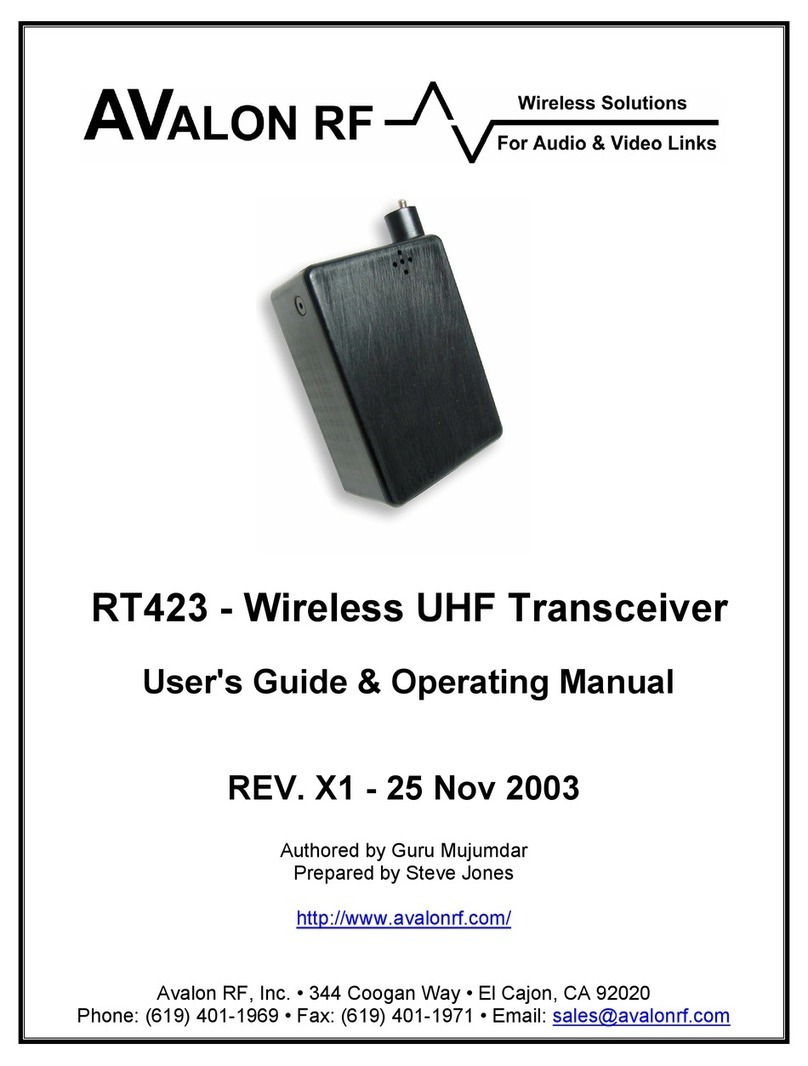
Avalon RF
Avalon RF RT423 User's guide & operating manual
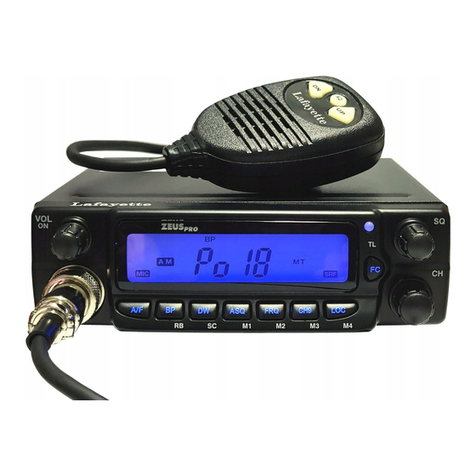
Lafayette
Lafayette ZEUS user manual

Standard Horizon
Standard Horizon HX870 owner's manual

Midland
Midland G14 Instruction guide
